Platform Patio Furniture: An In-Depth Guide
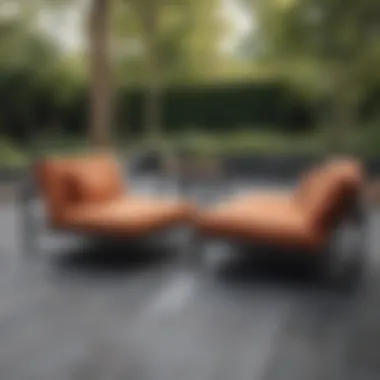
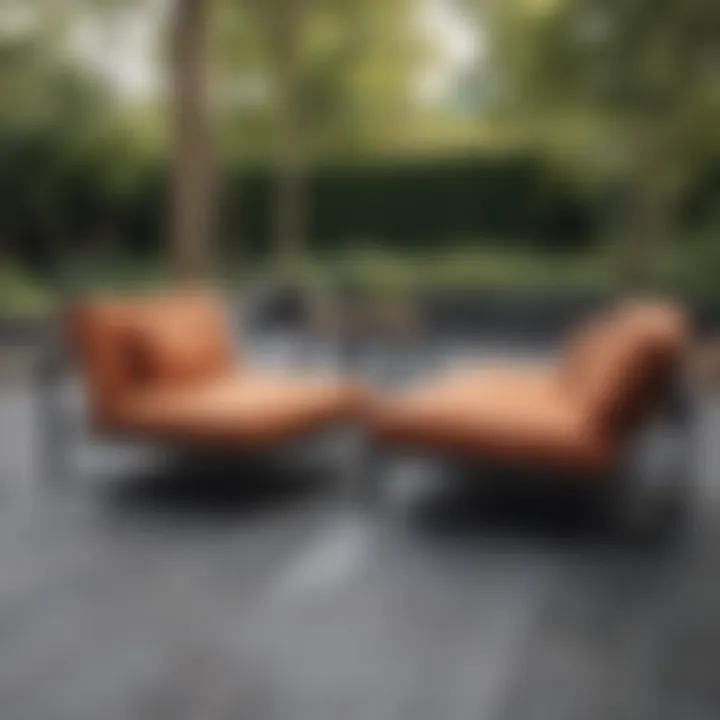
Intro
In today’s world, where outdoor living spaces are increasingly valued, platform patio furniture emerges as a central element for homeowners and design enthusiasts alike. This guide aims to dissect the nuances of platform patio furniture—from intricate design trends to practical maintenance tips—ensuring you’re well-equipped to create an inviting outdoor oasis.
As we dive into this modern and versatile style, it’s clear that the right patio setup can transform your garden, balcony, or porch into a serene retreat. So, let’s embark on this journey together, exploring the many facets of platform pieces that make outdoor gatherings not just possible, but truly enjoyable.
Furniture Design Trends
Current Styles and Aesthetics
Platform patio furniture has a unique aesthetic that often embodies a minimalist approach, focusing on clean lines and open spaces. The contemporary styles vary, but many incorporate natural elements that harmonize well with the outdoors. Think geometric shapes blended with organic textures.
Popular styles include:
- Scandinavian: Characterized by simplicity and functionality, these pieces use light woods paired with neutral upholstery.
- Modern Coastal: A trend that reflects a beachy vibe, this style often features wicker or rattan structures with soft, pastel colors and sea-inspired patterns adorning cushions.
- Industrial: Metal frames combined with weather-resistant wood or concrete give a robust appearance, suitable for urban settings.
The key to choosing the right style is ensuring it resonates with the existing architecture of your home and enhances the overall aesthetic of your outdoor space.
Color Palettes and Materials
When it comes to colors, the choices can range widely, although nature-inspired shades tend to dominate. Greens, browns, and soft blues create a seamless transition from indoors to outdoors. In contrast, pops of vibrant colors can serve as stunning focal points.
Materials play a crucial role in the longevity and appearance of patio furniture. Here’s a rundown of some suitable options:
- Teak Wood: Highly durable and resistant to weather, it’s a classic choice for high-end designs.
- Aluminum: Lightweight yet strong, aluminum is perfect for mobility and can resist rust, making it a great option for various environments.
- Synthetic Rattan: This material mimics the look of natural wicker while offering better weather resistance, ensuring your furniture stays beautiful for a long time.
"Selecting materials wisely can significantly affect the comfort, maintenance levels, and lifespan of your patio furniture."
Buying Guides
Essential Considerations When Purchasing
Investing in platform patio furniture is no small feat; thus, there are several essentials to keep in mind before making a purchase:
- Size and Scale: Measure your outdoor space to avoid overcrowding. Leave enough room for movement and any additional decor.
- Durability: Considering how the furniture will endure the elements, select pieces made from weather-resistant materials.
- Comfort: Don’t settle on aesthetic appeal alone—opt for comfortable cushions and ergonomic shapes that invite you to relax.
Top Recommendations for Different Budgets
No matter the budget, there are options that don't compromise style or quality. Here are a few selections divided by price range:
Budget-friendly:
- IKEA’s APPLARO series: Offers functional simplicity at a wallet-friendly price.
- Mainstays at Walmart: Affordable and offers various styles, great for a quick refresh of your outdoor setup.
Mid-range:
- Wayfair's Sol 72 Outdoor Collection: Offers stylish options with durable materials.
- Target's Project 62: A trendy collection that doesn’t break the bank while providing modern designs.
High-end:
- Royal Teak Collection: Known for exquisite craftsmanship and high-quality teak furniture.
- Brown Jordan: Offers luxurious designs that combine form and function.
With this guide, homeowners, designers, and DIY enthusiasts are now better equipped to navigate the world of platform patio furniture, aligning their choices with both personal aesthetics and practical needs.
Understanding Platform Patio Furniture
When it comes to outdoor entertaining or simply enjoying a relaxed afternoon in your backyard, platform patio furniture plays a critical role. It's not just about having a place to plop down; the right furniture can transform a simple space into a cozy retreat or a stylish setting for gatherings. Understanding platform patio furniture involves diving into the unique characteristics that differentiate it from traditional options, as well as the benefits it brings to the table.
Defining Platform Patio Furniture
Platform patio furniture is generally characterized by its elevated design and low-to-the-ground profiles. This style emphasizes a more modern and minimalist approach, which appeals to contemporary sensibilities. Unlike conventional patio sets that may tower over a garden or lawn, platform pieces sit closer to the ground and often exhibit clean lines and sleek forms. The term "platform" itself evokes a sense of stability and foundation, making it an inviting option for relaxed lounging and socializing.
Furthermore, these furniture pieces can vary significantly in terms of materials, aesthetic styles, and functionality. They are often modular, allowing homeowners to mix and match to suit their unique outdoor spaces. In practical terms, this means that choosing platform patio furniture is about more than just aesthetics; it’s an investment in versatility and comfort that can greatly enhance how we enjoy our outdoor environments.
Historical Evolution of Patio Furniture
The journey of patio furniture is fascinating, somewhat like a story of its own. Back in the day, garden seating was made from natural elements, think of wood logs and stones, and it was quite rudimentary. As time marched on, materials evolved. In the 1920s and 30s, wrought iron and wicker started to take center stage as people sought more comfortable and elegant outdoor options.
By the late 20th century, vinyl and plastic became prevalent, catering to the need for durability at a lower cost. Fast-forward to today, platform patio furniture combines modern materials such as aluminum, teak, and synthetic resins designed for resilience and style. These pieces not only meet the functional needs of outdoor living but also reflect greater awareness of aesthetic appeal and design integrity.
With an increasing push towards environmentally friendly practices, today's designers are also incorporating sustainable materials, thereby giving a nod to eco-conscious consumers. The evolution of patio furniture mirrors changing lifestyles and cultural values, influenced by everything from economic conditions to social trends.
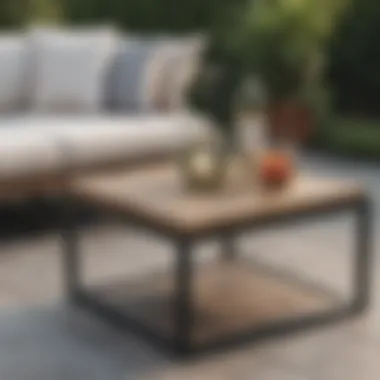
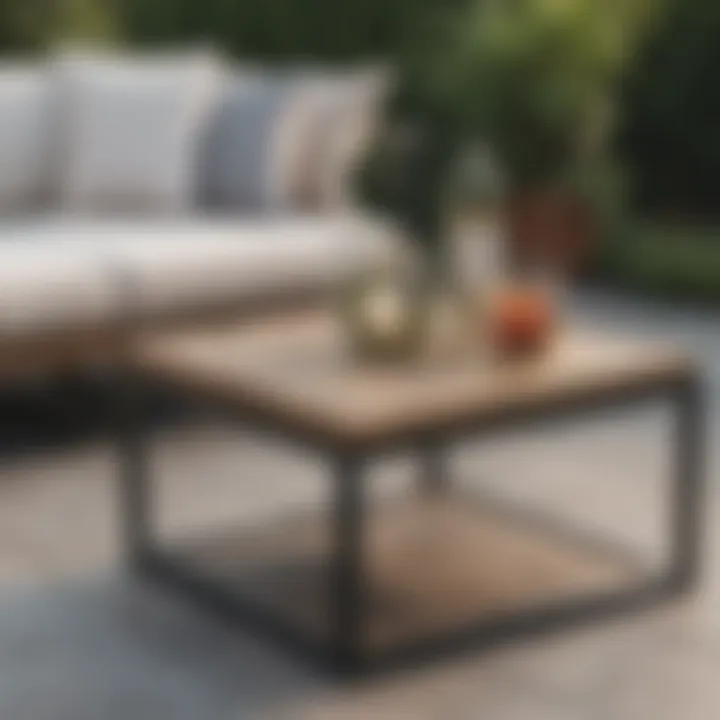
Ultimately, understanding platform patio furniture is essential for anyone looking to elevate their outdoor experience. By grasping its unique definition and background, homeowners, designers, and DIY enthusiasts alike can make informed choices that marry comfort with style.
Key Features of Platform Patio Furniture
The realm of platform patio furniture encompasses an array of features that enhance outdoor living spaces. When selecting furniture for eyes or relaxation, understanding these key attributes can significantly affect your enjoyment and satisfaction. Let's delve into the structural and aesthetic aspects that make this type of furniture stand out.
Structural Overview
Platform patio furniture primarily distinguishes itself through its robust construction. Unlike traditional patio sets that may wobble or lack stability, platform designs utilize a flat base that assures steady balance and security. Most of these pieces are made from resilient materials such as aluminum, teak, or synthetic wicker. This construction can withstand the elements, whether it's violent wind or relentless downpours.
Furthermore, the weight distribution of platform furniture plays a major role in its stability. Even if a gust of wind sweeps through, these designs tend to remain anchored due to their solid bases. This is particularly beneficial for families with kids or pets, as it minimizes the likelihood of accidents or damage.
In addition to stability, the versatility in configurations is another highlight. Homeowners can easily mix and match pieces—be it sofas, coffee tables, or chaise lounges—to fit the unique layout of their outdoor spaces. This adaptability ensures that even smaller patios can accommodate a snug fit, leaving no space unused.
Aesthetic Considerations
Aesthetics can make or break the visual appeal of your outdoor area, and platform patio furniture offers a striking blend of style and function. Designers often emphasize contemporary lines with minimalist designs, which allows these pieces to blend seamlessly into any garden or balcony setting.
Color choices are vast, extending beyond traditional earth tones. Today, brighter hues and even pastels are making waves in the market, letting homeowners express their personal style. Such options can inject a sense of vibrancy, creating an appealing contrast with the greenery surrounding a patio.
Moreover, the material finishes play a significant role in aesthetics. For instance, natural wood grains invoke a sense of warmth and coziness, while metal finishes offer a more modern touch. This amalgamation enables consumers to select pieces that resonate with their taste, ultimately enhancing their outdoor experience.
To sum it up, the features of platform patio furniture are not merely functional but also integral to the style of your outdoor space. Striking a balance between structure and aesthetics is key in making informed decisions that suit your lifestyle and enhance your home's appeal.
"A well-furnished patio isn't just a space; it’s an extension of your living experience."
Balancing functionality with visual allure ensures that your outdoor setup remains inviting and practical. The next sections of this guide will further explore crucial aspects of material selection and design considerations that contribute to the longevity and aesthetics of your patio furniture.
Material Selection for Platform Patio Furniture
Choosing the right material for your platform patio furniture is both an art and a science. It's not just a matter of aesthetics; the materials you select dictate durability, maintenance, comfort, and overall longevity. In a market flooded with options, understanding the nuances of material selection becomes crucial for homeowners, designers, and DIY enthusiasts who aim to create inviting, functional spaces outdoors.
When we think about outdoor furniture, we must consider how it will withstand the elements while maintaining its visual appeal. Rain, snow, and UV rays are relentless adversaries against your patio furnishings. Beyond just looks, every material carries its own personality and functionality. Hence, diving into the common materials used and their characteristics will set the stage for making informed decisions.
Common Materials Used
There is a multitude of materials that patio furniture can be made from, each with its distinct pros and cons:
- Aluminum: Lightweight and resistant to rust, aluminum furniture is great for folks who frequently rearrange their outdoor spaces. Its sleek modern look appeals to many urban dwellers. However, it can be a bit prone to denting.
- Teak Wood: This is often considered the gold standard of outdoor furniture. Its rich grain and natural oils make it resilient against moisture and pests. As it ages, it develops a beautiful silver patina. However, teak requires maintenance to keep its hue vibrant and may be pricier than other types of wood.
- Synthetic Wicker: Made from plastic or resin, synthetic wicker is durable and weather-resistant. It offers the stylish appearance of traditional wicker without the issues of rotting or fading. But, watch out for cheaper versions that can become brittle in extreme temperatures.
- Steel: Heavy and sturdy, steel offers durability and can hold up against the strongest winds. Yet it is prone to rust unless coated properly, so check for finishes that enhance its weather resistance.
- Fabric: Lastly, outdoor fabrics like solution-dyed acrylics or polyester blends provide comfort and style but should be chosen carefully for their UV and water-resistant properties.
Durability and Weather Resistance
Durability is perhaps the kingpin when considering materials for patio furniture, and weather resistance is undoubtedly a close second. Each material should be evaluated based on how well it can stand up to the conditions prevalent in your area.
- Moisture Resistance: Depending on where you live, you might experience different levels of humidity and rainfall. For regions with high moisture, materials like teak and aluminum can hold up well against the dampness.
- UV Protection: Sunlight can bleach colors and weaken materials over time. Fabrics specifically designed for outdoor use will be treated to withstand UV rays. Ensure that items like aluminum and synthetic wicker are powder-coated or treated to combat fading.
- Wind Resistance: If your outdoor area is subject to high wind, heavier metals like steel will likely fare better than lighter options. You can sometimes use weighted bases for umbrellas or cushions to prevent them from blowing away.
- Maintenance Needs: High-maintenance options might require regular upkeep. For example, teak might need annual oiling to maintain its appearance. On the other hand, aluminum or synthetic options may demand less.
Understanding the importance of selecting suitable materials sets the groundwork for a successful patio. It’s about crafting a balance between style, durability, and function. Selecting improperly can result in premature replacements and disappointments.
Ultimately, whether you are creating a cozy nook or an entertaining area, the materials you choose can significantly affect how you interact with your outdoor space. Think through these options carefully and let your lifestyle guide the way.
Design Considerations for Outdoor Spaces
Creating an outdoor space that blends seamlessly with the environment requires thoughtful design choices. The notion of design considerations in outdoor spaces isn’t just about aesthetics; it's about functionality, comfort, and sustainability. In selecting platform patio furniture, one must consider how the style, color, and overall layout contribute to the ambiance of the area while also catering to practical needs. The right choices elevate the experience, inviting gatherings and relaxation.
Choosing the Right Style
When it comes to choosing the right style for platform patio furniture, different tastes and lifestyles come into play. The style should not only reflect personal aesthetics but also merge well with the surrounding landscape. For instance, opting for a sleek, modern design complements contemporary homes, while rustic finishes may appeal to those with a more traditional taste.
- Consider Local Aesthetics: It might help to observe local architectural styles or even neighboring gardens. What fits well with their ambiance might resonate with your outdoor vision as well.
- Furniture Scale and Scale: Ensure the size of the furniture aligns with the space. Bulky furniture in a small area may create a cramped feeling, whereas smaller pieces could get lost in a vast expanse.
- Function Over Form: Always prioritize functionality. If hosting is in your plans, prioritize comfort and styles that facilitate social interaction like sectional sofas or modular pieces.
- Versatility is Key: Mix and match styles but aim for a cohesive look. A combination of weathered wood tables with sleek metal chairs, for instance, can create a dynamic yet harmonious environment.
Color Schemes and Patterns
Colors have a profound impact on the mood and functionality of outdoor spaces. Mainly, when considering color schemes and patterns, one should aim for colors that create balance and complement not just the furniture, but the entire outdoor setting.
- Neutral Base Colors: Starting with neutral tones provides a versatile foundation. Shades of beige, gray, or white allow for seasonal adjustments in accessories without clashing.
- Accents Make a Difference: Use vibrant cushions, throw blankets, or outdoor rugs as accents. These can make a statement without overwhelming the overall design.
- Nature-Inspired Choices: Draw inspiration from nature. Earthy tones like greens, browns, and deep blues align the furniture with the surroundings, fostering a sense of oneness with nature.
- Mixing Patterns: Don’t shy away from mixing patterns. Pair patterned cushions with a solid sectional to create visual interest while keeping the space grounded.
In essence, the color and style of outdoor furniture extend beyond mere preferences; they encapsulate the spirit of the place and often set the tone for memorable moments spent in the fresh air.
With the right design considerations in mind, homeowners can create inviting outdoor spaces that enhance their homes' beauty and functionality. The balance of style, color, and layout propels outdoor areas from being just an extension of the home into a retreat that encourages relaxation and interaction.


Placement Strategies for Platform Patio Furniture
Understanding the importance of effective placement strategies for platform patio furniture is essential in creating an inviting and functional outdoor space. Different aspects come into play, such as how the arrangement can enhance usability, maintain aesthetics, and ensure an enjoyable experience for anyone using the area. By carefully considering where each piece of furniture goes, you can maximize comfort and the flow of activities while highlighting the beauty of your surroundings.
Optimizing Space Utilization
When it comes to outdoor areas, space is often at a premium. Smart placement can make all the difference. Start by evaluating the dimensions of your area. Is it a cozy nook, or do you have a sprawling patio? Identifying the size and shape determines how much furniture you can use without it feeling cramped. Here are some handy tips for optimizing space:
- Measure and Plan: Take accurate measurements of your patio; knowing the dimensions is crucial. Use graph paper or any design app to sketch ideas before moving furniture around.
- Prioritize Key Pieces: Focus on essential items first, like a dining table or loungers. Once you have those in place, fill in with smaller decor pieces like side tables or plants.
- Multi-Functional Furniture: Choose items that serve multiple purposes. For example, a storage bench can act as both seating and a place to stash cushions or tools.
By approaching placement with a strategic mindset, you ensure that every square foot serves a purpose, keeping the area feeling open and comfortable rather than congested.
Creating Functional Zones
In addition to optimizing space, creating functional zones within your patio can vastly improve how the area functions. Segmentation can turn an ordinary patio into a versatile extension of your living space. Here’s how to go about it:
- Identify Activities: Think about what activities will take place outdoors. Do you envision hosting dinner parties? Or, perhaps, relaxing with a good book? Define the primary uses of your space.
- Designate Areas: Once you know your activities, organize zones for different functions:
- Visual Cues: Use rugs, planters, or even outdoor screens as dividers to delineate zones without creating barriers. This subtle separation adds interest without sacrificing an open feel.
- Dining Zone: A table with chairs can become the heart of your gatherings.
- Lounge Zone: A seating area with comfortable chairs or a sectional sofa makes for a great conversation corner.
Functional zoning not only increases the utility of your outdoor space but it adds depth and character, making it a more engaging place to spend your leisure time.
Maintenance and Care of Platform Patio Furniture
When it comes to platform patio furniture, ensuring longevity and sustained aesthetic appeal hinges on diligent maintenance and care. This section zeros in on specific practices for keeping your outdoor investments in good shape, helping you maintain both functionality and style. Failure to care for patio furniture can lead to accelerated wear and tear, which is not only a waste of both time and money but can also detract from the overall beauty of your outdoor space.
Good maintenance isn’t just about cleanliness; it’s also about preserving the integrity of your chosen materials, whether they feature wood, metal, or other composites. Regular attention to these aspects can prevent inconveniences down the road and keep your patio looking fresh as a daisy.
"A stitch in time saves nine" – a little bit of upkeep now can save you a world of trouble later.
Regular Cleaning Practices
Hygiene plays a pivotal role in the upkeep of patio furniture. Each material has its quirks and needs, so here’s a breakdown of effective cleaning practices:
- Wooden Furniture: Dust and debris can easily accumulate on wooden surfaces. A soft, damp cloth is usually sufficient. For deeper cleans, consider using a gentle soap mixed with water. Rinse well to avoid soap residue, which can be a real pain.
- Metal Furniture: Metals like aluminum or stainless steel can be quite resilient. However, water stains or rust spots can form over time. Using a non-abrasive cleaner and a soft sponge can easily rectify this. Don’t forget to dry it thoroughly to prevent new water spots!
- Fabric Cushions: If your platform furniture includes fabric or canvas, these should be treated with a fabric protector to withstand outdoor elements. Regular spot cleaning with mild detergent and water helps reduce grime buildup and keep colors vibrant.
It’s best practice to schedule routine cleanings, ideally every month or so, depending on your environment. If you live in a particularly windy or leafy area, spacing out cleanings can prevent dirt from becoming more embedded.
Seasonal Storage Tips
As seasons shift, so do the needs of your outdoor space. Protecting platform patio furniture from Mother Nature’s wrath can extend its lifespan significantly. Here are some actionable tips for smart seasonal storage:
- Find Cover: If possible, invest in high-quality covers that are specifically designed for your furniture. They help in keeping dust and debris at bay while shielding against rain and snow.
- Indoor Storage: Whenever the cold winter months roll around, bring your furniture inside if you have the space. This can be as simple as moving cushions and small tables into a garage or shed. They won’t take up much space, and you’ll save the headache of damage.
- Elevation: For pieces that can’t be moved, consider lifting them off the ground using wood blocks. This keeps them from direct contact with the damp ground during wet seasons, which helps prevent rust or mold from developing.
- Maintenance Before Storage: Give everything a thorough cleaning before putting it away for the season. It’s much easier to clean when it’s not buried in snow or mistreated by rain.
Taking the time to properly maintain and care for your platform patio furniture can make all the difference. Simple cleaning routines and seasonal strategies not only enhance the look but ensure that your outdoor living space remains inviting and stunning year-round.
Pairing Platform Patio Furniture with Outdoor Decor
When it comes to crafting an inviting outdoor space, the marriage between platform patio furniture and decor is crucial. This is not just about slapping some chairs and a table out in the yard. Rather, it’s about orchestrating a blend of design elements that create a cohesive, stylish, and functional area for relaxation and entertainment. The right pairing can significantly enhance the livability of your outdoor environment, reflecting your personal taste while also accommodating the natural surroundings.
There are specific benefits tied to this harmonious blend, like enhancing the overall aesthetic of your space or improving functionality for gatherings. Think of it as dressing up your outdoor area to make it feel complete. A well-coordinated approach can turn an ordinary patio into a striking extension of your home.
Complementing Natural Elements
One of the primary considerations when pairing platform patio furniture with outdoor decor involves natural elements. Whether you’re surrounded by verdant gardens, a coastal breeze, or a rustic woodsy backdrop, aligning furniture with nature greatly uplifts the ambiance.
- Material Harmony: If your surroundings boast a lot of wood and greenery, consider furniture made from natural materials like teak or eucalyptus. Such choices echo the environment and create a seamless look. Alternatively, furniture with metal accents can offer a contemporary flare against a traditional garden.
- Color Palette: Opting for earth tones or muted colors can help your furniture blend in rather than protrude. Gentle greens, browns, and soft neutrals often work best. This doesn’t mean you have to forgo pops of color; vibrant cushions or an umbrella can provide just enough contrast without overwhelming the natural aesthetics.
- Floral Accents: Introducing planter boxes or hanging pots can beautifully frame your furniture without monopolizing valuable space. A couple of climbing vines or succulents not only enhance visual interest but also foster a sense of tranquility.
Taking cues from the surrounding landscape creates a harmonious feel, allowing outdoor areas to serve as a natural retreat.
"Incorporating nature into your decor doesn't just beautify your backyard; it fosters a sense of peace and calm that urban life often lacks."
Incorporating Accessories and Accents
Adding accessories and accents is like icing on the cake for platform patio furniture. While the furniture provides structure, accessories inject personality and warmth into the space. Knowing where to focus your efforts can elevate your outdoor area completely.
- Textiles: Think about vibrant cushions, throws, or outdoor rugs to bring comfort to your seating. Fabrics can tie in colors from nearby flowers or your house's exterior, offering a unified look. Make sure to choose fade-resistant materials, as outdoor elements can be unforgiving on delicate fabrics.
- Lighting: Lanterns or string lights can add a magical touch once the sun goes down. Soft, ambient lighting enhances the experience, making the patio an inviting spot for evening gatherings. Not to forget, solar lights positioned around your furniture not only illuminate but can uplift overall safety after dark.
- Seasonal Decor: Consider rotating items that reflect the seasons. Wreaths or decorative centerpieces can keep themes fresh and interesting. During colder months, swap out lighter textiles for richer hues and heavier fabrics that beckon you to cozy up.
You might find that accessories not only reflect your style but also create a story that unfolds every time you head outdoors, inviting more use and enjoyment of the space.
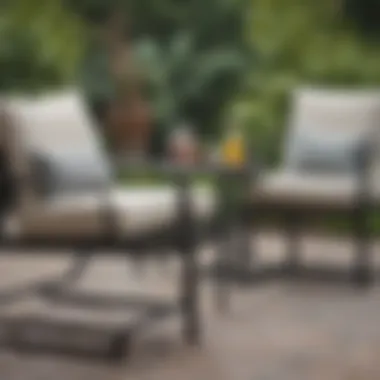
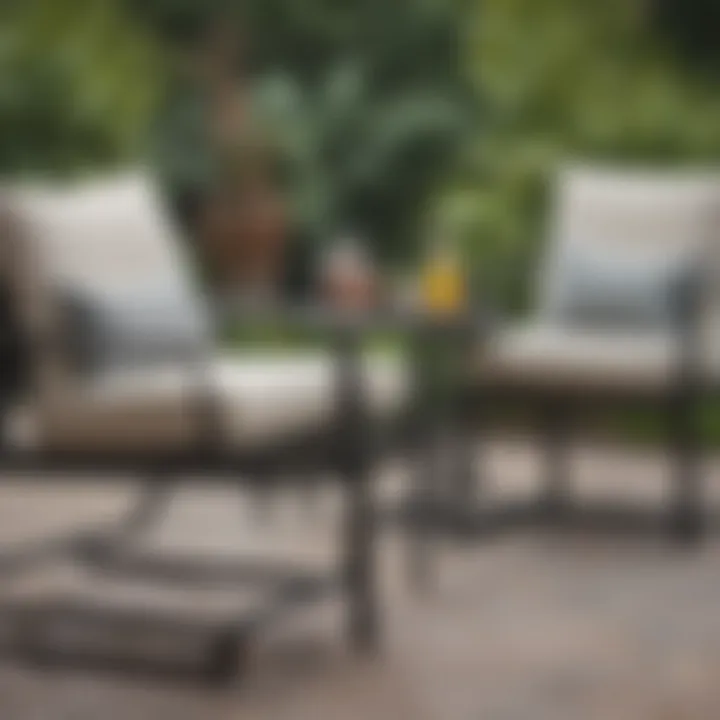
By thoughtfully pairing platform patio furniture with outdoor decor, you’re not just designing a space; you’re creating an experience. It's a chance to reflect your personal style while creating an inviting environment, perfect for cozy summer evenings or lively gatherings with friends.
Sustainability in Platform Patio Furniture
Sustainability has become a buzzword in the design and manufacturing of various products, and patio furniture is no exception. As homeowners increasingly search for ways to minimize their environmental impact while enjoying their outdoor spaces, the focus on sustainable platform patio furniture has never been more relevant. Not only do these choices reflect a growing awareness of our responsibility towards the planet, but they also provide practical benefits that can enhance the longevity and utility of outdoor furniture.
One key aspect of sustainability in this arena involves selecting materials that are eco-friendly and ethically sourced. By opting for sustainable options, homeowners are not only making a statement about their values but are also investing in products that are less harmful to the environment. This can include the use of reclaimed wood or recycled metals that conjure up an aura of rustic elegance. Many manufacturers are now turning to bamboo, which grows rapidly and absorbs carbon dioxide far more efficiently than traditional hardwoods.
"Choosing sustainable materials is like hitting two birds with one stone - you get to enjoy your space while also taking care of it."
Furthermore, embracing sustainability goes beyond material selection; it correlates directly to the craftsmanship behind the products. Furniture built with intention, durability, and quality care usually equates to longevity. Scale models that prioritize thoughtful design and production methods not only guarantee beautiful aesthetics but affirm a commitment to environmental stewardship. With all this in mind, let's look closely at two critical elements within this sustainability discussion: eco-friendly material options and longevity and reusability.
Eco-Friendly Material Options
When it comes to choosing eco-friendly materials for platform patio furniture, options abound. Here’s a look at some noteworthy choices:
- Recycled Aluminum: Lightweight yet sturdy, this material is resistant to rust and can last for decades. Plus, it can be reshaped again and again without losing quality, making it a true champion in sustainability.
- Teak Wood: While it is important to source it from sustainably managed forests, teak is renowned for its durability and weather resistance. Unlike other woods, teak requires minimal maintenance, which keeps its life cycle intact.
- Bamboo: A grass rather than a wood, bamboo grows incredibly fast with minimal resource input, which makes it a remarkable sustainable choice. It offers a unique aesthetic with its inherent beauty.
- Post-Consumer Recycled Materials: Some brands incorporate plastics and other materials that have been recycled after use, effectively reducing waste while creating robust, attractive furniture.
Choosing furniture made from these eco-friendly materials not only supports environmental health but enhances the overall ethos of outdoor living spaces.
Longevity and Reusability
The sustainability of platform patio furniture also hinges heavily on its longevity and potential for reuse. This is not just about the initial purchase; it’s about how these pieces can serve you over the long haul. Here are several points to consider:
- Durable Construction: Furniture that is well-constructed tends to withstand the test of time and weather, reducing the need for replacements. Look for brands that emphasize quality joinery, sturdy bases, and quality finishes.
- Timeless Design: Investing in timeless and classic designs means these pieces remain relevant for years. This reduces the temptation to replace them for aesthetic updates, fostering a more sustainable approach to outdoor décor.
- Repairability: Some patio furniture features replaceable components, making repairs far easier—saving both money and resources. For instance, simple elements like cushions or slats can often be replaced or refinished with little hassle.
- Adaptability: Many designs allow modifications or re-upholstering, enabling you to refresh your outdoor setup without forsaking existing furniture. This adaptability embodies the concept of reusability while adding individuality.
In essence, focusing on the longevity and reusability of platform patio furniture can greatly contribute to a more sustainable lifestyle. By thoughtfully curating outdoor spaces around these principles, homeowners can enjoy their environment while engaging in eco-friendly practices.
The Future of Platform Patio Furniture
As we look ahead, the landscape of platform patio furniture is shaping up to be quite exciting. With changing lifestyle preferences and an increasing focus on sustainability, what we once knew about outdoor living spaces is evolving. No longer are these spaces mere extensions of our homes; they are considered integral parts of our daily life. This shift beckons a variety of new designs, materials, and functionalities that cater to our needs and feelings.
One notable aspect is the growing demand for versatility. Homeowners are looking for furniture that does more than just sit pretty; they want pieces that can adapt for various occasions, from quiet family dinners to vibrant evening parties. This trend toward multi-functionality reflects a broader shift in how we approach living spaces. People want their patios to be cozy, yet stylish, and furniture that can change forms or features as required resonates well with this desire.
"Platforms are the great equalizers of outdoor furniture; they allow imagination and utility to blend seamlessly."
Emerging Trends and Innovations
Several trends are beginning to capture designers and homeowners alike. For instance, modular furniture is at the forefront. These pieces can be rearranged and reconfigured according to the specific needs of the moment. Imagine a sectional sofa that transforms into individual lounge chairs - now that's valuing flexibility!
In addition, biophilic design is really taking hold. This trend emphasizes a connection to nature, with more companies integrating plants into their furniture designs. Think about a coffee table with built-in planters or chairs that incorporate greenery. This design philosophy not only beautifies the space but promotes well-being by bringing nature closer.
Moreover, smart furniture is on the rise. Concepts such as solar-powered charging stations or integrated Bluetooth speakers are appealing to tech-savvy consumers. These innovations add an extra layer of convenience, letting us enjoy modern amenities outside in a stylish and practical way.
Technological Advancements in Materials
An important facet of the future lies within the materials used in platform patio furniture. The recent surge in sustainable materials is not just a passing fad. People are seeking products made from recycled or bio-based materials that reduce environmental impact. Furniture made from recycled plastics or reclaimed wood is becoming more mainstream and accepted, highlighting the importance consumers place on eco-friendliness.
Additionally, innovations in weather-resistant materials have revolutionized the market. Advanced polymers and composite materials have emerged, allowing for lighter yet stronger structures, which resist the elements better than traditional options. This will not only enhance longevity but significantly improve the user experience when it comes to outdoor upkeep.
In this rapidly evolving marketplace, discerning homeowners and designers would do well to pay attention to these trends. The future of platform patio furniture is indeed bright, reflecting a balance between style, utility, and sustainability. As innovation continues, the excitement surrounding outdoor spaces is bound to grow even further.
Making Informed Purchasing Decisions
Navigating the world of platform patio furniture can be quite a task. Understanding how to make informed purchasing decisions stands as a cornerstone of ensuring the right choices for your outdoor space. This goes beyond just picking out trendy pieces; it’s about recognizing the long-term benefits and the nuances that come with quality and design. When armed with the right knowledge, you can invest wisely and ensure that your outdoor environment is both functional and a feast for the eyes.
Evaluating Quality and Value
When it gets down to it, quality cannot be understated. Platform patio furniture can often appear similar at first glance, but a deeper dive reveals significant differences in build, materials, and durability.
To evaluate the quality:
- Material matters: Look for materials like teak, aluminum, or high-density polyethylene. These not only boast aesthetic appeal but also stand up to the elements.
- Construction techniques: Items that have been constructed with care show it. Check for sturdy joints and overall finish. A well-made chair shouldn’t creak when you sit in it.
- Weight and Stability: Heavier items typically suggest better quality because they are less likely to be blown over by unexpected gusts of wind.
Value comes from the intersection of cost and longevity of a piece. While it might be tempting to go for the least expensive option, consider the trade-offs. A cheaper set may require replacements within a few seasons, while an investment in quality can yield years of enjoyment. It pays to think of these purchases as long-term investments.
"Remember, it’s not just about what you’re spending now; it’s about what you’re saving later by choosing quality that lasts."
Where to Buy Platform Patio Furniture
Now that you are aware of what to look for in terms of quality and value, the next logical step is figuring out where to make these purchases. There are countless venues to shop for platform patio furniture, but your choice can significantly influence your buying experience.
- Local Retailers: Sometimes, there’s no substitute for seeing and feeling the product in person. Local furniture stores often have knowledgeable staff who can provide insights and recommendations.
- Online Platforms: Websites like Wayfair, Walmart, or Amazon offer a vast range of options that can be browsed at home. Additionally, check reviews for first-hand accounts of customer satisfaction.
- Specialty Outdoor Furniture Stores: These shops often have a curated selection, ensuring they offer only quality items. The staff usually has specialized knowledge about outdoor furniture.
- Manufacturers' Outlets: For those in the know, buying directly from the manufacturer can lead to substantial savings. You might not have the widest selection, but prices can be more favorable.
- Marketplace Platforms: Websites like Facebook Marketplace or Craigslist can offer good deals, but always be cautious of the condition of the items. It requires a bit of a gamble, but sometimes there are gems out there waiting to be found.
Choosing where to buy platform patio furniture requires consideration and deliberate thought. By focusing on quality and making wise purchasing decisions, you set the stage for a beautiful and lasting outdoor retreat.















